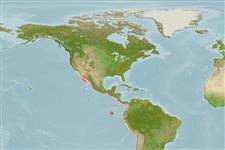>
Carangiformes (Jacks) >
Carangidae (Jacks and pompanos) > Caranginae
Etymology: Chloroscombrus: Greek, chloros = green + Greek, skombros = the name of several fishes, a mackerel (Ref. 45335).
More on authors: Jordan & Gilbert.
Environment: milieu / climate zone / depth range / distribution range
Ekologi
marina; brackvatten bentopelagisk. Subtropical; 33°N - 18°S, 122°W - 70°W
Eastern Pacific: San Pedro, southern California, USA to Peru, including the Gulf of California.
Size / Vikt / Age
Maturity: Lm ? range ? - ? cm
Max length : 30.0 cm TL hane/ej könsbestämd; (Ref. 9283); common length : 18.0 cm TL hane/ej könsbestämd; (Ref. 55763)
Body oval and strongly compressed; snout short and blunt; chest covered with scales; lateral line conspicuously curved anteriorly, with 6 to 14 very weak scutes along the caudal peduncle; lower branch of first gill arch with 9 to 12 gill rakers; body and head blue green; flanks and belly silvery; edge of operculum with very characteristic black stain; dorsal region of caudal also stained black (Ref. 55763).
Adults form schools in coastal marine and brackish waters, including lagoons with mangroves (Ref. 9283). Often make a grunting sound when captured (Ref. 9283). Marketed fresh, salted and fried (Ref. 9283).
Life cycle and mating behavior
Könsmognad | Reproduktion | Lek | Ägg | Fecundity | Larver
Eschmeyer, W.N., E.S. Herald and H. Hammann, 1983. A field guide to Pacific coast fishes of North America. Boston (MA, USA): Houghton Mifflin Company. xii+336 p. (Ref. 2850)
IUCN Red List Status (Ref. 130435)
Threat to humans
Harmless
Human uses
Fiskeri: mindre kommeriell
Ytterligare information
referenserVattenbrukVattenbruksprofilAvelslinjerGenetikElectrophoresesÄrftlighetSjukdomarBehandlingNutrientsMass conversion
Verktyg
Special reports
Download XML
Internet-källor
Estimates based on models
Preferred temperature (Ref.
123201): 20.5 - 28.4, mean 25.2 °C (based on 70 cells).
Phylogenetic diversity index (Ref.
82804): PD
50 = 0.7500 [Uniqueness, from 0.5 = low to 2.0 = high].
Bayesian length-weight: a=0.00794 (0.00509 - 0.01239), b=2.93 (2.80 - 3.06), in cm total length, based on LWR estimates for this species & (Sub)family-body (Ref.
93245).
Trofisk nivå (Ref.
69278): 2.5 ±0.4 se; based on diet studies.
Resiliens (Ref.
120179): Hög, lägsta populationsfördubblingstid mindre än 15 månader (Assuming tm=1).
Fishing Vulnerability (Ref.
59153): Low vulnerability (20 of 100).
Climate Vulnerability (Ref.
125649): Low to moderate vulnerability (26 of 100).
Nutrients (Ref.
124155): Calcium = 107 [57, 228] mg/100g; Iron = 1.38 [0.80, 2.63] mg/100g; Protein = 18.7 [17.6, 19.9] %; Omega3 = 0.391 [0.222, 0.714] g/100g; Selenium = 30.1 [16.1, 57.4] μg/100g; VitaminA = 12.5 [3.8, 32.7] μg/100g; Zinc = 1.26 [0.89, 1.80] mg/100g (wet weight);
